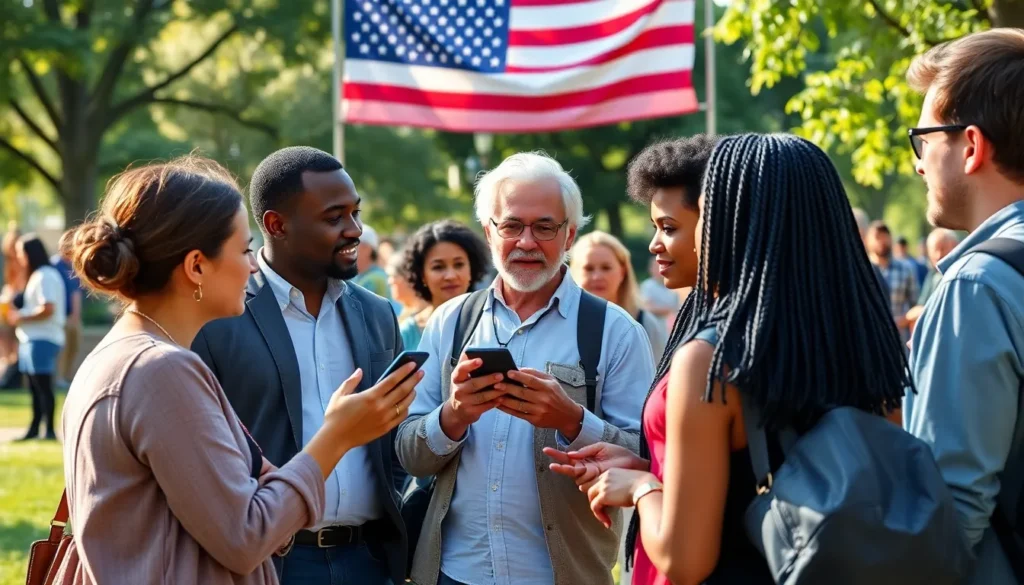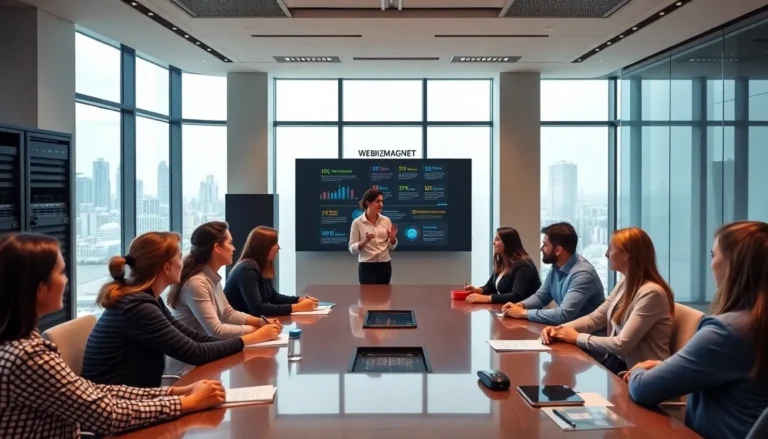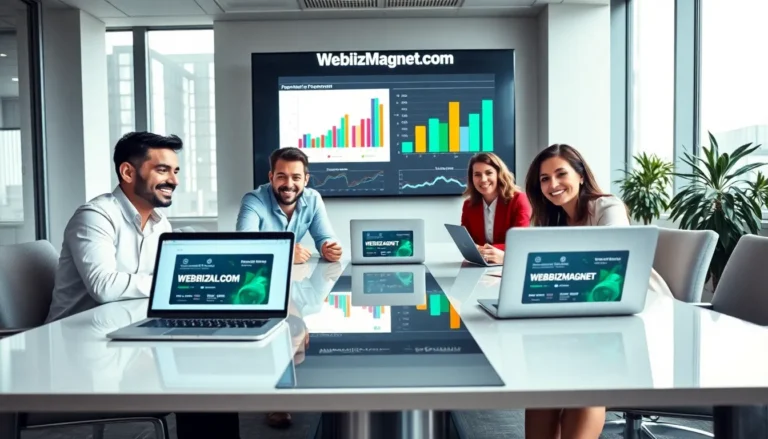Table of Contents
ToggleIn a world where tweets can topple governments and memes shape public opinion, political media has become the ultimate battleground for hearts and minds. It’s not just about the news anymore; it’s a high-stakes game where every headline could sway the next election. With the click of a button, they can ignite debates, fuel outrage, or even inspire a dance challenge.
Understanding Political Media
Political media encompasses various formats that inform the public about political issues. This sphere includes traditional news outlets, online platforms, and social media channels that directly impact public perceptions and political behaviors.
Definition and Scope
Political media refers to content created to communicate political information, engage citizens in discourse, and influence opinions. Platforms such as television, newspapers, and radio deliver traditional journalism, whereas social media provides immediate, interactive discussions. Political media plays a critical role in elections, shaping voter perceptions and opinions through campaigns and advocacy messages. Campaign advertisements, press releases, and political commentary are typical content examples. Its scope extends beyond mere reporting, making it integral to the democratic process by empowering voters and holding leaders accountable.
Historical Context
The evolution of political media traces back to the invention of the printing press in the 15th century. This innovation enabled the mass distribution of pamphlets and newspapers, fostering public engagement in political debates. The 20th century saw the rise of radio and television, creating new avenues for politicians to reach audiences directly. Changes in technology led to more interactive forms of communication in the 21st century, such as blogs and social media. These platforms allow for rapid dissemination of information, broadening access to political discourse. Political media’s development mirrors shifts in society, reflecting changing communication styles and audience expectations through time.
The Role of Political Media Today

Political media plays a crucial role in contemporary society by shaping public perceptions and influencing political dynamics. Various formats, from traditional news outlets to social media platforms, contribute to the dissemination of information regarding political matters.
Influence on Public Opinion
Political media significantly influences how the public perceives issues. Social media platforms, in particular, shape opinions through real-time discussions. A study from Pew Research Center indicates that 64% of Americans consume news on social media, highlighting its reach. Memes and shareable content also amplify specific narratives, making them widely accessible. This interaction fosters polarized views, often leading to an echo chamber effect that reinforces existing beliefs. Additionally, the immediacy of online content can sway public opinion at critical moments, heavily impacting conversations around current events.
Impact on Political Campaigns
Political campaigns rely heavily on media strategies to effectively engage voters. Campaigns today often utilize targeted ads on social media, reaching specific demographics with tailored messages. According to the Federal Election Commission, approximately $1.4 billion was spent on digital ads in the 2020 election cycle. This illustrates the growing importance of online platforms in election strategies. Engaging with voters through social media also facilitates direct communication, allowing candidates to respond to questions and concerns promptly. Traditional media still retains influence, as endorsements and coverage shape perceptions of candidates. Overall, political media creates an essential backdrop for campaigns aiming to sway public sentiment and mobilize voters.
Types of Political Media
Political media includes various formats that inform the public about political issues. Understanding the primary types helps clarify their unique roles in shaping public opinion.
Traditional Media
Traditional media encompasses newspapers, television, and radio. These outlets have historically played an essential role in reporting political news. Journalistic integrity often underpins the credibility of these sources. Though digital alternatives have risen, traditional media remains influential in setting the agenda. News articles, broadcasts, and editorial pieces provide in-depth analysis on political matters. According to the Pew Research Center, 50% of adults still prefer news from traditional outlets, highlighting their ongoing importance in the media landscape.
Digital Media
Digital media includes websites, blogs, and online news platforms that deliver political content. This form allows for quicker updates and broader reach. Content produced by digital media often targets specific interests or demographics. It includes articles, videos, and podcasts that provide commentary and insights on current political events. Engagement metrics, such as shares and comments, indicate the effectiveness of digital media in sparking discussions. Approximately 45% of the public accesses political information through these online channels, reflecting their growing significance.
Social Media
Social media serves as a dynamic platform for political discourse and engagement. Platforms like Twitter and Facebook enable real-time conversations around political events. Users can express opinions, share content, and mobilize support for causes quickly. Memes and hashtags often influence public perception and agenda-setting. A significant 64% of Americans consume news through social media, showcasing its pervasive nature. These platforms offer candidates direct access to voters, fostering a new political communication style. In this context, social media becomes a vital component of modern political campaigning.
Challenges in Political Media
Political media faces several challenges that can undermine its effectiveness.
Misinformation and Fake News
Misinformation spreads rapidly across digital platforms, impacting public perception and decision-making. It’s estimated that 70% of Americans encounter misinformation online. This phenomenon complicates the already intricate landscape of political discourse. Fake news can distort facts, leading to confusion among citizens. Social media platforms are often breeding grounds for these inaccuracies, as users share unverified content. Engaging fact-checkers and reliable sources becomes critical to combatting this issue. Efforts by organizations like the International Fact-Checking Network highlight the necessity of verifying information in real-time. By prioritizing accurate reporting, political media can enhance credibility and trust within the public sphere.
Media Bias
Media bias significantly influences how political information is presented and perceived. Research suggests that 62% of Americans believe news organizations are politically biased. Such bias can shape narratives, impacting voter opinions and shaping electoral outcomes. Different platforms may favor particular political viewpoints, distorting public understanding. This variance in coverage often leads to polarized audiences who consume news that aligns with their beliefs. Audiences must be aware of potential biases while navigating political media. Promoting diverse perspectives allows for a more comprehensive understanding of issues. Fostering critical media literacy among the public can empower individuals to evaluate sources effectively.
The Future of Political Media
Political media evolves rapidly in response to societal changes. Trends indicate a shift toward personalized content delivery. Increasingly, users prefer engaging formats that resonate with their interests and beliefs.
Trends and Innovations
Innovations in political media focus on interactive content. Augmented reality and virtual reality experiences enhance voter engagement. Polarization remains a concern, with fact-checking tools becoming vital. Real-time analytics help campaigns tailor messages effectively. A study by the Knight Foundation found that 77% of participants support better access to information. As new platforms emerge, adaptability will remain crucial for media strategies in politics.
The Role of Technology
Technology significantly influences political media dynamics. Artificial intelligence processes vast data sets, allowing campaigns to target specific demographics. Social media algorithms also determine content visibility, shaping public discourse. Pew Research indicates that 46% of voters receive political information from social media feeds. Furthermore, mobile technology enables instant updates, strengthening communication channels. Candidates use live streaming to create direct connections with audiences, enhancing transparency and trust.
Political media’s influence on society is undeniable as it shapes public perception and drives political engagement. The evolution from traditional news to dynamic social media platforms reflects changing communication styles and audience expectations. As misinformation and media bias challenge the landscape, the importance of critical media literacy grows.
Looking ahead, technological advancements will continue to transform political media. Personalized content and innovative tools will enhance voter engagement while addressing the need for transparency and accountability. Understanding these trends is essential for navigating the complexities of modern political discourse and ensuring informed participation in the democratic process.







